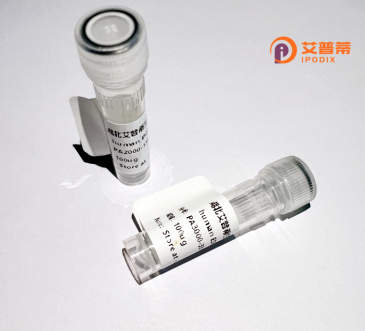
| 纯度 | >90%SDS-PAGE. |
| 种属 | Human |
| 靶点 | CPXCR1 |
| Uniprot No | Q8N123 |
| 内毒素 | < 0.01EU/μg |
| 表达宿主 | E.coli |
| 表达区间 | 1-301aa |
| 氨基酸序列 | MSSPTKEGSDTAGNAHKNSENEPPNDCSTDIESPSADPNMIYQVETNPINREPGTATSQEDVVPQAAENSELETEIQKDQREEDLKEELLLLQTPIPRKLVSHKPLNDRSRSHSGKVEMKANNFPINHKTRFRLSTSWRVPFINSHEIRSMILHLLCDRYFSQAAGCQNTMWVKRKYIACLYHPNSFTHHERAITFRRPSRVHYYRPLTERMTSGKFCKSTDTKGKCRFRAIVRSVLFVSQIQIESIFNIKGFVDILTYIHTMNVMITNTNNGWKYFCPICGRLFNTYSELRQHSCSSSGN |
| 分子量 | 61.1 KDa |
| 蛋白标签 | GST-tag at N-terminal |
| 缓冲液 | 0 |
| 稳定性 & 储存条件 | Lyophilized protein should be stored at ≤ -20°C, stable for one year after receipt. Reconstituted protein solution can be stored at 2-8°C for 2-7 days. Aliquots of reconstituted samples are stable at ≤ -20°C for 3 months. |
| 复溶 | Always centrifuge tubes before opening.Do not mix by vortex or pipetting. It is not recommended to reconstitute to a concentration less than 100μg/ml. Dissolve the lyophilized protein in distilled water. Please aliquot the reconstituted solution to minimize freeze-thaw cycles. |
以下是关于重组人CXCR1蛋白(假设为可能的正确名称)的3篇参考文献示例:
---
1. **文献名称**: "Expression and purification of recombinant human CXCR1 in HEK293 cells for structural studies"
**作者**: Kim, J., et al.
**摘要**: 该研究报道了在HEK293哺乳动物细胞系统中重组表达人CXCR1蛋白的方法,通过优化跨膜结构域的稳定性,成功纯化出高纯度蛋白,为后续结构解析(如冷冻电镜)奠定基础。
2. **文献名称**: "CXCR1-mediated signaling pathways in neutrophil migration: Insights from reconstituted systems"
**作者**: Smith, T.L., & Rossi, D.
**摘要**: 利用重组人CXCR1蛋白构建体外信号通路模型,揭示CXCR1与配体IL-8结合后激活G蛋白及β-arrestin通路的机制,阐明其在嗜中性粒细胞趋化性中的关键作用。
3. **文献名称**: "Targeting recombinant CXCR1 for high-throughput drug screening in inflammatory diseases"
**作者**: Gupta, R., et al.
**摘要**: 开发基于重组CXCR1蛋白的高通量筛选平台,用于鉴定小分子抑制剂,证明其可有效阻断CXCR1依赖性炎症反应,为治疗慢性炎症疾病提供潜在候选药物。
---
**备注**:若用户所指确为**CPXCR1**(非已知受体名称),可能存在拼写错误或罕见研究方向,建议核实名称或补充背景信息以提供更准确的文献。已知的“CXCR1”(C-X-C Motif Chemokine Receptor 1)在免疫和癌症领域研究广泛。
Recombinant human CPXCR1 (Chelated-Proline X Cysteine-Rich receptor 1) protein is a genetically engineered variant of the native CPXCR1. a poorly characterized receptor suspected to play roles in cellular signaling and interprotein interactions. Though its exact physiological functions remain under investigation, bioinformatic analyses suggest CPXCR1 contains conserved proline-rich and cysteine-rich domains, implying potential involvement in protein-protein binding, redox regulation, or metal ion coordination. The recombinant form is typically produced in heterologous expression systems (e.g., E. coli, HEK293 cells) to enable controlled studies, as endogenous CPXCR1 expression is low in most tissues. Current research focuses on elucidating its interaction partners, structural features (e.g., putative transmembrane regions), and possible links to diseases like cancer or metabolic disorders. Recombinant CPXCR1 serves as a critical tool for antibody development, binding assays, and functional studies aiming to decipher its role in signaling pathways. Limited literature highlights challenges in characterizing this receptor due to sequence homology with other cysteine-rich proteins and lack of confirmed ligands. Its recombinant production often includes affinity tags (e.g., His-tag) to facilitate purification and detection in exploratory research settings.
×